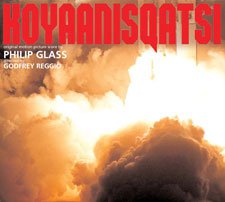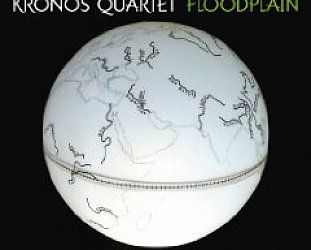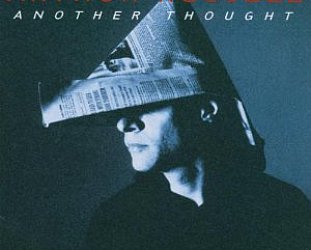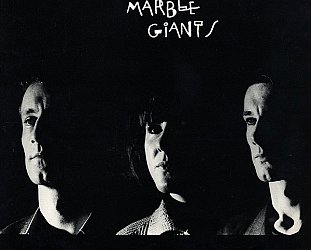Graham Reid | | 3 min read
Philip Glass: Resource

There are few things more depressing than observing a revolution become a style (or the Beatles’ Revolution become a Nike ad). Or to witness innovation morph into cliché.
When director Godfrey Reggio’s innovative film Koyaanisqatsi appeared in the early Eighties it had an immediate impact on popular music and film culture.
Ostensibly a narration-free look at the impact of man on the landscape -- the title comes from the Hopi language and means life out of balance, or life in turmoil -- the images of industrialisation, strip mining, destruction of the land and waterways, and the manic pace of cities actually made audiences stop and think.
Cinematographer Ron Fricke’s use of time-lapse photography (clouds racing across the sky) and slow motion (the waltz-like explosion of the Atlas-Centaur rocket and its graceful yet tragic fall to Earth at the end) were innovative and breath-taking.
Of course both techniques had been used frequently in the past, but when combined with the music of Philip Glass they became emotionally elevated and compelling.
Glass’ repetitive, minimalist music had also been around for many years but the vehicle of the film took his soundtrack beyond the world of contemporary classical and into cinemas, hearts and homes across the world.
It was a rare conjunction where sound and vision seemed in perfect harmony, each adding to the emotional impact of the other.
It isn’t overstating to say that the film is masterpiece: it works on every technical level; has a moving story arc; juxtaposes images of Man and Nature to create the sense they are needless adversaries and bears witness to the power of both; delivers an un-stated but obvious subtext that something needs to change; and was undeniably influential in the environmental movement as much as it was on film-makers.
And for the latter, Koyaanisqatsi became a template to borrow and steal from.
Within a year the jazz-rock violinist Jean Luc Ponty (formerly in Frank Zappa’s band) was enjoying massive MTV success with a clip to his piece Individual Choice which used the same time-lapse treatment.
Ad agencies were quick to adopt (without adapting) the inventiveness of Reggio/Fricke to their own purposes and soon enough innovation became cliché.
Glass’ music fared somewhat better however, and although you would frequently see an ad, doco sequence or short film where time-lapse came with minimalist phrases, the film opened the door for Glass into a world beyond Downtown New York and the music for elaborate contemporary operas by Robert Wilson: his aural signature of repeated phrases and overlapping melodic lines (which would seem unvarying until the slightest change sounded like seismic shift) became familiar in places he never otherwise have reached.
He continued his classical work for operas, plays and theatre productions, but Koyaanisqatsi took him into the profitable and equally challenging world of soundtracks: he scored for Mishima, Martin Scorsese’s Kundun, the two Koyaanisqatsi sequels (Powaqqatsi in ‘88 and Naqoyqatsi in ’02), The Illusionist and numerous others.
But for many, the dramatic, brooding and intense score to Koyaanisqatsi remains his most affecting work: it opens with a sense of deep foreboding (bass voices chanting the title) and then moves through a series of intricately related sections which perhaps owe as much to the German electronica movement of the Seventies as they do the aural fingerprint of minimalism as Glass and Steve Reich had come to define.
The soundtrack was released in an abbreviated form shortly after the film came out (there was 87 minutes of soundtrack, the album had only 45) and in the late Glass Nineties re-recorded the music (slightly revising some sections and adding previously unheard pieces) taking it close to the 75 minute mark.
In 2009 the complete original soundtrack was released on Orange Mountain Music and it included some of the sound effects from the film.
Whatever the version, this remains music of great emotional impact and not only brought minimalism into the mainstream but gave Philip Glass (and others such as Reich) a greater audience than he had enjoyed previously.
Suddenly, because of Koyaanisqatsi, everyone was into minimalism (and time-lapse photography). “Everyone” unfortunately including the ad agencies, video clip makers, movie and doco directors . . .
Innovation became cliché, but the groundbreaking impact of Koyaanisqatsi -- not just the film or the music, but the two taken together -- remains.
These Essential Elsewhere pages deliberately point to albums which you might not have thought of, or have even heard . . .
But they might just open a door into a new kind of music, or an artist you didn't know of. Or someone you may have thought was just plain boring.
But here is the way into a new/interesting/different music . . .
Jump in.
The deep end won't be out of your depth . . .







post a comment